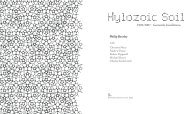The Inner Studio - Riverside Architectural Press
The Inner Studio - Riverside Architectural Press
The Inner Studio - Riverside Architectural Press
Create successful ePaper yourself
Turn your PDF publications into a flip-book with our unique Google optimized e-Paper software.
North American cities, native settlements and camps existed here<br />
for thousands of years before European traders arrived. <strong>The</strong> flat<br />
land surrounding the rivers and lakeshore was decent farming land<br />
and a European settlement grew into an agricultural center as well<br />
as a gateway to northern towns where the lure of fur and mineral<br />
exploitation generated a steady migration of settlers. You could say<br />
there are two kinds of towns in Ontario; mining towns and farming<br />
towns. Toronto took hold as a farming town and developed a<br />
reputation for being earnest and industrious. <strong>The</strong> Royal Winter<br />
Fair, an annual showcase of animals, farm produce, and horseriding<br />
skills is our reminder that we are tied to the land. <strong>The</strong> early<br />
folk name for the city was Hog Town. Those less inclined to value<br />
animals came up with the name “Toronto the Good,” a name that<br />
some say reflected how difficult it was to buy an alcoholic drink.<br />
Cities as Siblings<br />
TORONTO: THE CITY WHO IS WHOLE<br />
Three hundred and fifty miles upriver was Montreal, a place that<br />
was everything Toronto was not. Montreal was charismatic,<br />
cultured, and full of grand ambition and natural good looks. It had<br />
a surplus of city riches. A mountain and a river ensured unique<br />
geography and the friction of French and English founders<br />
provided a rich and complex culture. Montreal was the obvious<br />
choice for corporate wealth and the city seemed to dance its way<br />
effortlessly into the “A” division of places in North America and<br />
the world.<br />
Meanwhile, Toronto continued making its unremarkable decisions.<br />
<strong>The</strong> city became a scrabble of upright Victorian brick houses<br />
on a straightforward grid of tree-lined streets that formed clusters<br />
of small town-like communities, each grouped around its own<br />
main street. <strong>The</strong> differences from neighborhood to neighborhood<br />
were subtle. Every house was like a proud but modest farm house,<br />
most with wooden porches, perhaps matching bay windows, small<br />
front lawns, and back gardens. Unlike Montreal, which was built in<br />
stone, Toronto’s houses featured red bricks that came from our<br />
abundant supply of clay along the Don River. A special yellow brick<br />
was used for decoration and civic buildings such as libraries. <strong>The</strong><br />
179





